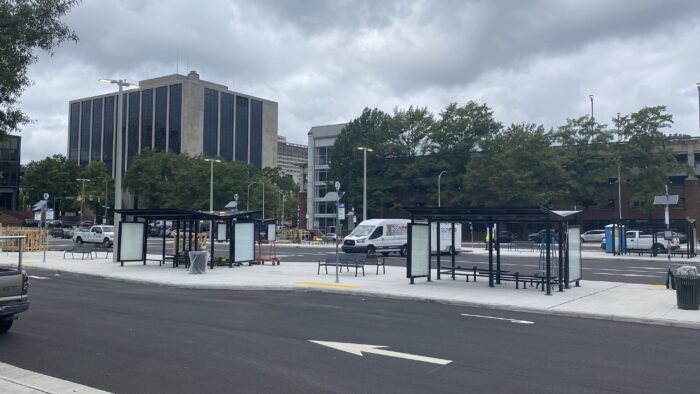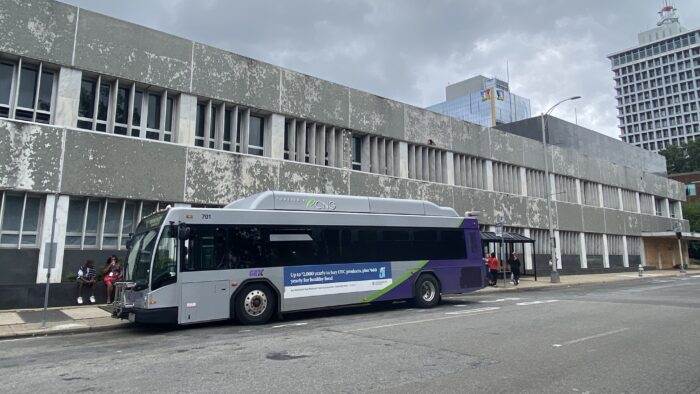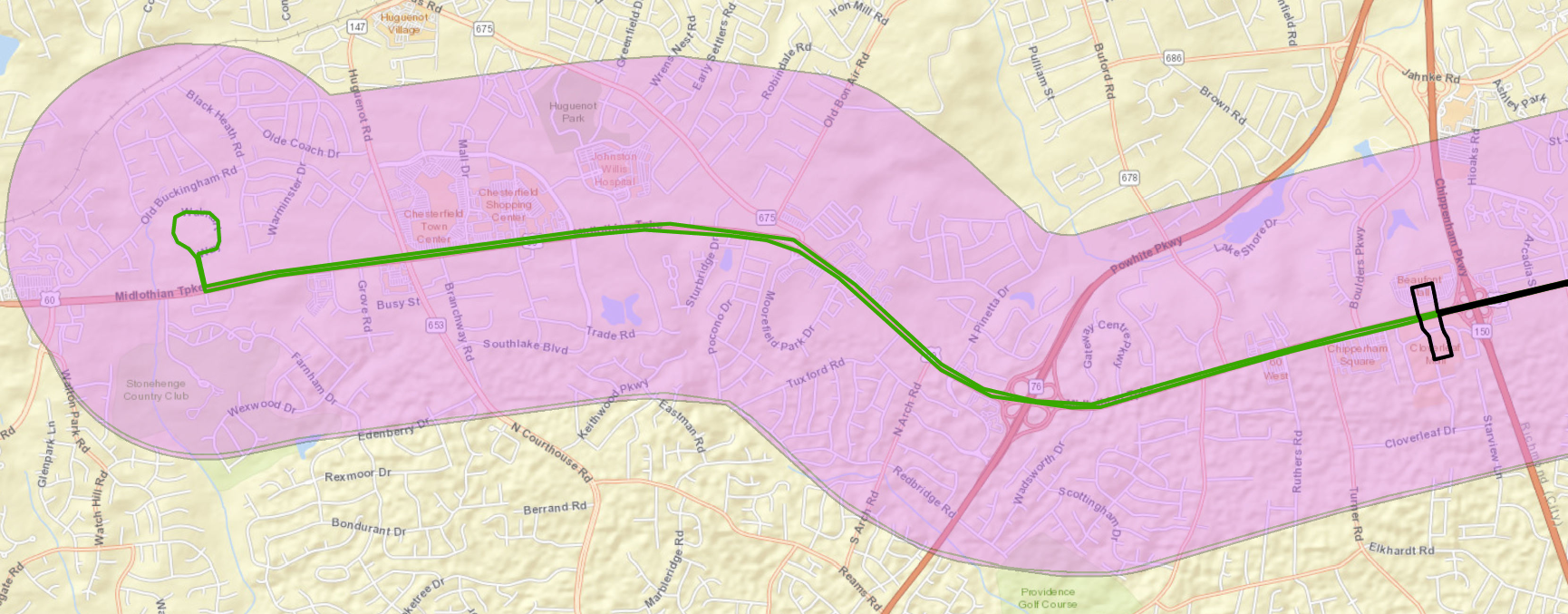
GRTC is preparing to open a new temporary transfer station in downtown Richmond. The facility is being established on a portion of a city-owned parking lot between East Leigh and East Clay streets. (Jack Jacobs photos)
As the regional transit authority gets ready to christen a new bus-route nexus in downtown Richmond, it’s also gearing up for a route expansion south of the river.
The Greater Richmond Transit Co. expects to begin operations at its new temporary downtown transfer station in September.
The station will be located on a city-owned parking lot that’s bordered by East Leigh, Ninth and Eighth streets. The site is next to the Richmond courthouse complex at 400 N. Ninth St.
The new station will feature 12 bus bays, as well as shelters for riders, 24-hour lighting and digital information kiosks. It will replace GRTC’s current temporary transfer hub on Ninth Street between Marshall and Leigh streets.
“It’s going to be brighter, easier to wait and we’re excited it’s an off-street location,” GRTC spokesman Henry Bendon said of the new station.
GRTC opened its current on-street transfer hub in 2014. It is moving to make way for the redevelopment of the city’s neighboring former Public Safety Building.
GRTC intends to eventually establish a permanent transfer station, though its location hasn’t been determined. The transit authority’s board of directors in August approved a $442,840 contract with consulting firm HR&A Advisors to identify potential sites for the permanent facility. The study is anticipated to take six months.
The downtown transfer station acts as a nexus point for GRTC’s bus route system, allowing bus routes from across the region to converge and shuffle riders in a central point. Riders make 5,000 trips through the current on-street hub a day.
“Downtown is a key source of jobs, it has healthcare facilities and it’s where people want to go. You can transfer between lines and it opens up more access to not just downtown but other parts of the city,” Bendon said. “You really do want a central point in the central business district for people to come from all different directions.”

GRTC currently operates a temporary transfer hub next to the soon-to-be-demolished Public Safety Building on Ninth Street.
Construction is largely complete on the new station, with final completion slated to come in the days before it begins operation Sept. 10. A ribbon-cutting ceremony is scheduled for the following day.
The latest budget for the project is $3.7 million. GRTC had previously estimated the project would cost $2.2 million, but Bendon said it increased due to inflation and supply challenges.
“Supply chain issues hit us throughout the construction process,” he said. The project has been financed with local, state and federal money.
The site being used by GRTC for the new transfer station is situated on a portion of a parking lot owned by the City of Richmond, which is leasing the site to the transit authority.
GRTC has a five-year lease on the lot with an option to renew, Bendon said. GRTC still has a little more than four years left on the agreement and is paying $1 per year for the lease.
Pilot route expansion planned on Midlothian Turnpike
With GRTC’s new transfer station nearly ready, the organization is also gearing up to establish a greater presence in Chesterfield County.
GRTC is extending its Route 1A on Midlothian Turnpike by eight miles, a project that will lengthen what is a highly traveled route farther along the major commercial corridor.
“It’s tens of thousands of jobs that will be available to Chesterfield residents and people who use the system. It’s an extension of one of our biggest and most important routes,” Bendon said.
An initial pilot run for the extension is expected to begin in January.
Route 1A currently ends just over the Richmond-Chesterfield line. The extension will send the line deeper into Chesterfield to Walmart Way, just west of Chesterfield Towne Center.
The pilot program is intended to gauge rider interest, through data points like on-time performance, operating expenses and ridership. The test could be followed by a permanent extension of the line. Bendon said the pilot will cost about $1.5 million to operate for one year.
GRTC is still working on where bus stops would be located on the extended route.

The extension of GRTC’s 1A Route along Midlothian Turnpike is shown in green. The pilot of the extended bus line is planned to start next year. The route’s current terminus is shown in black. In pink is the coverage area of a planned expansion of GRTC’s paratranist service that’s expected to launch along with the 1A extension. (Image courtesy of GRTC)
The expectation is that more drivers will be needed in order for GRTC to operate the planned route extension on Midlothian Turnpike.
Bendon said that GRTC has had recent success in addressing hiring challenges it and other transit operators have experienced in recent years. Among those efforts was the spring decision by the GRTC board to increase the starting hourly wage of drivers by 40 percent to nearly $25 per hour.
GRTC is on track to meet its goal of 300 full-time drivers by the end of the current fiscal year, which wraps up next June, Bendon said. The organization currently has 250 full-time drivers.
The transit system doesn’t charge fares to its riders as part of an ongoing zero-fare pilot program that was initiated in March 2020 and extended in December 2022. The program is currently slated to continue through June 2024, and GRTC could decide to continue the policy after that.
GRTC is operating on a $74.2 million budget for the current fiscal year 2024.

GRTC is preparing to open a new temporary transfer station in downtown Richmond. The facility is being established on a portion of a city-owned parking lot between East Leigh and East Clay streets. (Jack Jacobs photos)
As the regional transit authority gets ready to christen a new bus-route nexus in downtown Richmond, it’s also gearing up for a route expansion south of the river.
The Greater Richmond Transit Co. expects to begin operations at its new temporary downtown transfer station in September.
The station will be located on a city-owned parking lot that’s bordered by East Leigh, Ninth and Eighth streets. The site is next to the Richmond courthouse complex at 400 N. Ninth St.
The new station will feature 12 bus bays, as well as shelters for riders, 24-hour lighting and digital information kiosks. It will replace GRTC’s current temporary transfer hub on Ninth Street between Marshall and Leigh streets.
“It’s going to be brighter, easier to wait and we’re excited it’s an off-street location,” GRTC spokesman Henry Bendon said of the new station.
GRTC opened its current on-street transfer hub in 2014. It is moving to make way for the redevelopment of the city’s neighboring former Public Safety Building.
GRTC intends to eventually establish a permanent transfer station, though its location hasn’t been determined. The transit authority’s board of directors in August approved a $442,840 contract with consulting firm HR&A Advisors to identify potential sites for the permanent facility. The study is anticipated to take six months.
The downtown transfer station acts as a nexus point for GRTC’s bus route system, allowing bus routes from across the region to converge and shuffle riders in a central point. Riders make 5,000 trips through the current on-street hub a day.
“Downtown is a key source of jobs, it has healthcare facilities and it’s where people want to go. You can transfer between lines and it opens up more access to not just downtown but other parts of the city,” Bendon said. “You really do want a central point in the central business district for people to come from all different directions.”

GRTC currently operates a temporary transfer hub next to the soon-to-be-demolished Public Safety Building on Ninth Street.
Construction is largely complete on the new station, with final completion slated to come in the days before it begins operation Sept. 10. A ribbon-cutting ceremony is scheduled for the following day.
The latest budget for the project is $3.7 million. GRTC had previously estimated the project would cost $2.2 million, but Bendon said it increased due to inflation and supply challenges.
“Supply chain issues hit us throughout the construction process,” he said. The project has been financed with local, state and federal money.
The site being used by GRTC for the new transfer station is situated on a portion of a parking lot owned by the City of Richmond, which is leasing the site to the transit authority.
GRTC has a five-year lease on the lot with an option to renew, Bendon said. GRTC still has a little more than four years left on the agreement and is paying $1 per year for the lease.
Pilot route expansion planned on Midlothian Turnpike
With GRTC’s new transfer station nearly ready, the organization is also gearing up to establish a greater presence in Chesterfield County.
GRTC is extending its Route 1A on Midlothian Turnpike by eight miles, a project that will lengthen what is a highly traveled route farther along the major commercial corridor.
“It’s tens of thousands of jobs that will be available to Chesterfield residents and people who use the system. It’s an extension of one of our biggest and most important routes,” Bendon said.
An initial pilot run for the extension is expected to begin in January.
Route 1A currently ends just over the Richmond-Chesterfield line. The extension will send the line deeper into Chesterfield to Walmart Way, just west of Chesterfield Towne Center.
The pilot program is intended to gauge rider interest, through data points like on-time performance, operating expenses and ridership. The test could be followed by a permanent extension of the line. Bendon said the pilot will cost about $1.5 million to operate for one year.
GRTC is still working on where bus stops would be located on the extended route.

The extension of GRTC’s 1A Route along Midlothian Turnpike is shown in green. The pilot of the extended bus line is planned to start next year. The route’s current terminus is shown in black. In pink is the coverage area of a planned expansion of GRTC’s paratranist service that’s expected to launch along with the 1A extension. (Image courtesy of GRTC)
The expectation is that more drivers will be needed in order for GRTC to operate the planned route extension on Midlothian Turnpike.
Bendon said that GRTC has had recent success in addressing hiring challenges it and other transit operators have experienced in recent years. Among those efforts was the spring decision by the GRTC board to increase the starting hourly wage of drivers by 40 percent to nearly $25 per hour.
GRTC is on track to meet its goal of 300 full-time drivers by the end of the current fiscal year, which wraps up next June, Bendon said. The organization currently has 250 full-time drivers.
The transit system doesn’t charge fares to its riders as part of an ongoing zero-fare pilot program that was initiated in March 2020 and extended in December 2022. The program is currently slated to continue through June 2024, and GRTC could decide to continue the policy after that.
GRTC is operating on a $74.2 million budget for the current fiscal year 2024.
The 1A extension is the most important part. It shows that Chesterfield County is finally getting on board (pun intended) with public transportation. The success of the extension of route 3B to the Chester area was probably a driving factor. This is how a proper metropolitan area is supposed to work.
An extension of route 1 to Brook and Parham is also in the works I believe!
This is only a test. Chesterfield has done pilots with expanded routes before the real TEST will be when the pilot monies runs out (think LINK service from early 2000s) and if the BOS decides it want to allow permanent long-term funding for the route. Hope CVTA find success and the County will support the route after the pilot period.
True that. Most of the “free” rides are federally funded and run out in ’25.
Thank you for pointing this out — further, Munising tend to be willing to waste other people’s money even in well run places, but if the ridership isn’t there, they won’t waste the money even if some “sure it doesn’t work in Fact, but it works in THEORY!” People demand that it be kept going
Will GRTC ever get a “permanent ” transfer location? Every time they move their “temporary” transfer location it costs money. That money could be spent elsewhere in their system.
Willow Lawn has been a transfer station forever?
Willow Lawn is a major end point destination for bus riders due to the Pulse stopping there and due to how many shopping options are available nearby. However, it isn’t considered a transfer station.
It’s a valid question and it’s unfortunate the city didn’t allow it to be at Main Street Station, which could have been a true multi-modal hub. Hopefully with Henrico and Chesterfield now giving significant support to GRTC we will see more emphasis regionally on a permanent transfer station and adding more transit shelters across all routes.
Turning Main Street Station into a legitimate multi-modal-transit hub had been in the works — and included in RVA master plans — for decades. I recall while in undergrad at VCU in the early ’80s reading the city master plan and seeing this concept proposed. Unfortunately, all of the components that needed to come together to turn MSS into something amazing never came to pass. The city had wanted Amtrak, Greyhound and GRTC all operating within the Main Street Station “campus”. I believe Amtrak balked at any/all proposals to relocate Greyhound to the station – and over time interest in… Read more »
There is a HUGE multimodal center in Petersburg, paid with federal $$$$ of course, but I never see more people taking the bus…. maybe they will propose that they will PAY people to…….. oh…..shhhhhhhhh….
There is a \huge need for more proper bus shelters, places that are out of the rain and safe places for pedestrians to wait. Hopefully this is addressed soon.
This I don’t get. How can they push bus service so much and have so few benches or shelters? Granted the pulse has theirs but the rest of the city has seriously lacked. To push all this and not have a plan to put shelters at stops seems disingenuous.
Stop it now – you are making sense….
What about Stony Point Fashion Mall ??? The only city mall has no transportation to get there? I propose a city bus be assigned to take people there.. shopping, movies, restaurants ? Public transpo was obviously omitted from the mall plan.